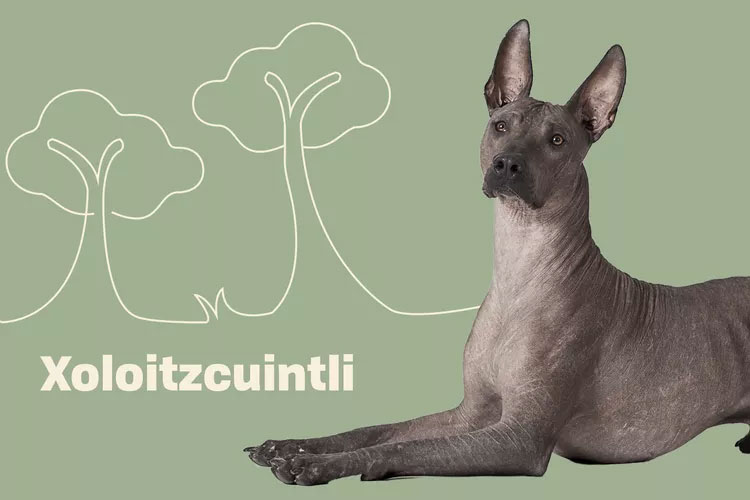
Xoloitzcuintli Overview
| OFFICIAL NAME | Xoloitzcuintli |
| COMMON NAME | Mexican Hairless |
| PET HEIGHT | 10 to 23 inches |
| PET WEIGHT | 10 to 55 pounds |
| LIFESPAN | 13 to 18 years |
| GOOD WITH | dogs, families, seniors |
| TEMPERAMENT | aloof, friendly, gentle |
| INTELLIGENCE | high |
| SHEDDING AMOUNT | infrequent |
| EXERCISE NEEDS | medium |
| ENERGY LEVEL | calm |
| VOCAL LEVEL | when necessary |
| DROOL AMOUNT | low |
| BREED GROUP | non-sporting |
| BREED SIZE | medium (26-60 lbs.) |
| COAT LENGTH | hairless, short |
| COLORS | black, brown / chocolate / liver, fawn, gold / yellow, gray, red, white |
| PATTERNS | bicolor, brindle, flecked / ticked / speckled, hairless, spotted |
| OTHER TRAITS | apartment-friendly, easy to groom, easy to train, high prey drive, hot weather tolerant, hypoallergenic, strong loyalty tendencies |
Xoloitzcuintli, pronounced "show-low-itz-QUEENT-ly" or "xolo'"("show-low") for short, is more commonly known as the Mexican hairless dog. This exotic breed is a calm, alert, and loyal companion. While the standard xolo is a medium-sized dog, weighing between 30–55 pounds, the breed can also be found in two smaller sizes as well: toy and miniature.
The xoloitzcuintli's history begins more than 3,500 years ago in Mexico and Central America. The ancient Aztec dog of the gods, xolos were loyal companions thought to ward off evil spirits. It was a good job ... until their owners died, when the dogs were often sacrificed and buried with their people (the belief was they'd help guide their owners into the afterlife).
Today, xolos live a more casual existence. Their unique look sets them apart from the rest of the pack, and xolo enthusiasts are quick to point out their strong, graceful bodies and calm, loving demeanors. What they lack in hair, these pups more than make up for in loyalty to their owners.
If you're looking to add a xoloitzcuintli to your household, it will likely set you back a few bucks. Costs vary widely depending on a variety of factors, but Kay Lawson, past president of the Xoloitzcuintli Club of America, says owners looking for a show-worthy dog should expect to spend somewhere in the range of $2,000 for a registered xolo.
Appearance
Xoloitzcuintlis are found in three sizes, according to the XCA: toy, which stands 10–14 inches tall and weighs between 10–15 pounds, miniature at 14–18 inches tall and between 15–30 pounds, and standard at 18–23 inches tall and 30–55 pounds.Unlike many dogs that were bred to develop certain traits, xoloitzcuintlis evolved naturally thousands of years ago, giving them a distinctive look that means they never go unnoticed. These primal-looking dogs have long, muscular bodies with long, low-set tails. Their large, upright ears and wrinkly brows that furrow when deep in thought show quizzical expressions that make it clear this is one smart, emotive dog.
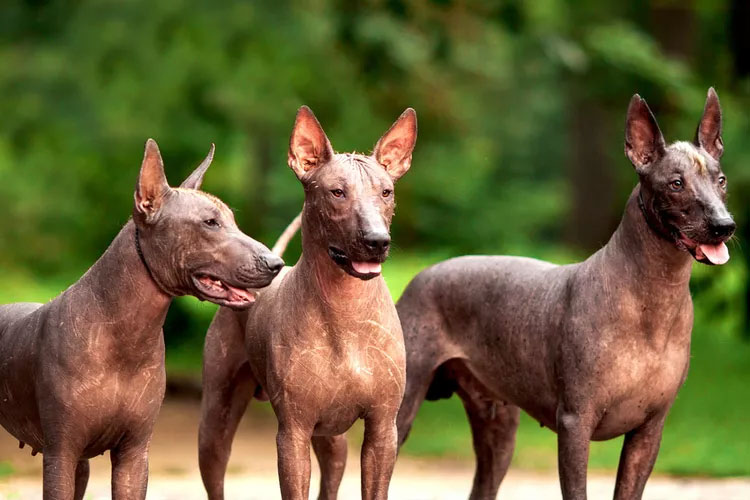
Xoloitzcuintli dogs can be either completely hairless, or sport a short, flat coat—and both the short-haired and sans-haired can be born in a single litter! Many even sport a small tuft of hair on their heads, like a little toupee. These small-to-medium-sized dogs have a striking appearance and tend to be a dark color: Typically black, gray, bronze, or red. They may also have white spots that give them a little extra flair to their interesting look.
While the hairless look is certainly not for everyone, xolo enthusiasts are passionate about keeping this native breed going strong. Lawson says the xoloitzcuintli's history resonates with her on a personal level, citing its status as a breed that's indigenous to the region. "We are both Native American," Lawson says. "The temperament and personality of this breed fit my personality. The backstory of the breed was intriguing, and [that's how I became] a preservation breeder."
Xolos might appeal to some people because of their lack of hair, which may be a help to those with allergies looking for a dog that doesn't make them sniffle or scratch. While a completely hypoallergenic dog is not a reality, it's possible that some dogs—the xoloitzcuintli included—may cause fewer allergy symptoms than others.
Rest assured that heading out for a walk with your xolo means you're a one-of-a-kind pair bound to turn some heads. These dogs are truly unique!
Temperament
"[Xolos] are highly intelligent and adaptable," Lawson says. "When properly bred and raised correctly, they are a primitive survivalist—not fragile and dependent—who are highly motivated to participate in whatever activity you are interested in."Lawson advises xoloitzcuintli owners that they'll need to commit a significant amount of time to train their xolo during puppyhood. These energetic pups need a lot of attention and exercise, so they may not be the best dog for a busy household without the ability to train and socialize their dog properly. While xolos have a reputation as great family pets, they may not have patience for the clumsiness of small children who tug on their ears or tail. As with any dog, it's important to supervise anytime kids and pups are together and teach your children how to properly interact with pets.
Xolos may also be slow to warm to strangers, so they won't be hamming it up like a Labrador for attention. They also make excellent watch dogs—they'll let you know if anything is amiss with a bark, but aren't particularly yappy.
Like most dogs, a properly trained, exercised, and cared for xolo will be a reliable companion for years to come. "They are, for the most part, a healthy, solid, athletic partner," Lawson says. "And a dog that will bond intensely with [his] owner."
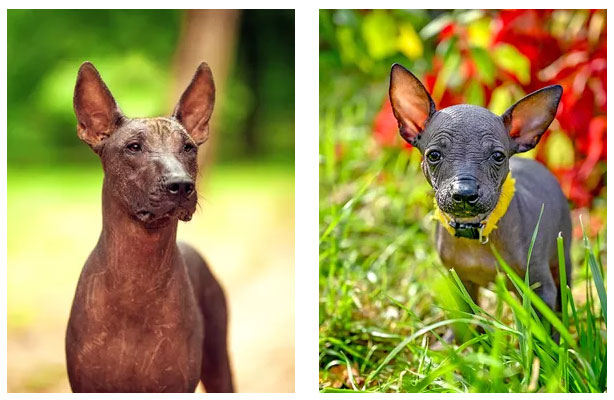
Living Needs
Xoloitzcuintlis need daily exercise, but nothing too extreme—they'll be happy with 20–30 minute walks twice a day and some off-leash playtime in a fenced-in yard. They are calm and happy in the house, and their manageable size and gentle temperament means they can make good apartment dogs, especially the toy and miniature pups.But take note: Xolos have a high prey drive, meaning they might like to chase other animals such as rabbits and squirrels. They're also excellent jumpers who have been known to easily scale a 6-foot fence. Even xoloitzcuintli puppies can be talented escape artists, so owners must be aware of their surroundings and supervise them so the pups don't go MIA. Teaching them to stay and come when called is vital, and make sure your xolo is always on a leash when not in a fenced space.
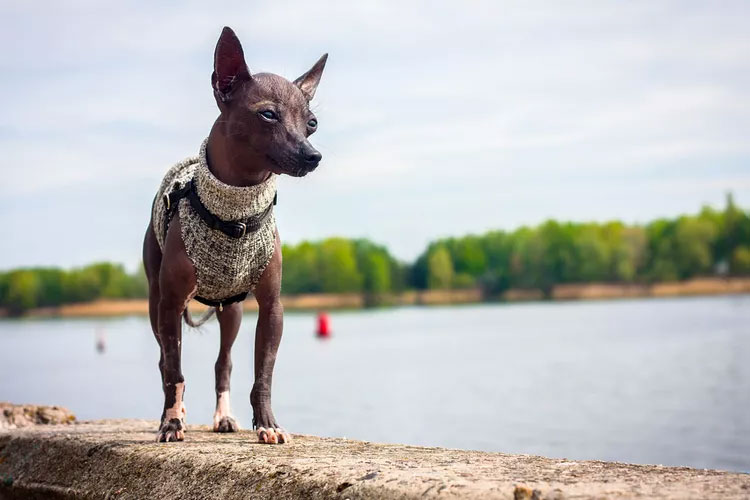
Because xolos don't have much (or any!) hair, they're better suited to warmer climates and will need a coat to go outside in the cold. But if it does get chilly, fear not: Xoloitzcuintlis love embracing the hygge lifestyle and are excellent cuddlers. And because they have no insulating layer of hair, their skin can feel very warm to the touch, like a comforting hot water bottle.
Care
Training a xolo is similar to other dogs, as they need consistency and react best to positive reinforcement. Because xoloitzcuintlis are adept learners who are easily able to grasp cues and learn tricks, they need a confident person to show these "show-lows" the ropes. They can be a bit strong-willed at times, so consistency is key; these pups might be best suited for experienced dog owners."Most importantly, they are not a dog that can just be left at home on their own for hours while their owners are away to work," Lawson says. "They will find a way to entertain themselves, and it most likely will not be in a way that you find acceptable. They don't do well when left crated for extended amounts of time."
Despite being hairless, a xoloitzcuintli still needs grooming. Xolos clean themselves like cats, but need regular baths to keep their skin healthy and clean. Because their skin is prone to burning, they need dog-formulated sunscreen (human sunscreen can be toxic for dogs) if they spend ample time outside in the sun. Their nails grow fast and should be trimmed often, and their teeth brushed regularly with dog formulated toothpaste.
Health
The typical xoloitzcuintli lifespan is a lengthy 13–18 years. They tend to be a healthy breed, and aren't prone to any serious genetic diseases.Skin care for these Mexican hairless dogs should be top of mind. If they do get cuts or abrasions, their tough skin tends to heal fast. But just like human teenagers, adolescent xolos can be prone to acne, according to the XCA, and regular baths can help keep their skin clear.
You may have seen cute pictures of xoloitzcuintlis with their tongues hanging out the sides of their mouths. Xolos often lose their premolars, the teeth located between canines and the molars, hence this cute look of a lolling tongue. This is normal and doesn't affect their ability to eat.
Speaking of food, it's important to note that xoloitzcuintlis have a tendency to overeat. Obesity can cause stress on their joints, so talk with your veterinarian about maintaining a healthy diet and how often to feed your xolo.
The OFA also names hip dysplasia, patellar luxation, and eye disorders as potential xoloitzcuintli health issues. Regular exercise and visits to the vet will help keep your xolo looking good and living a long life. Before bringing home a dog, make sure your xoloitzcuintli breeder completes all tests recommended by the OFA.
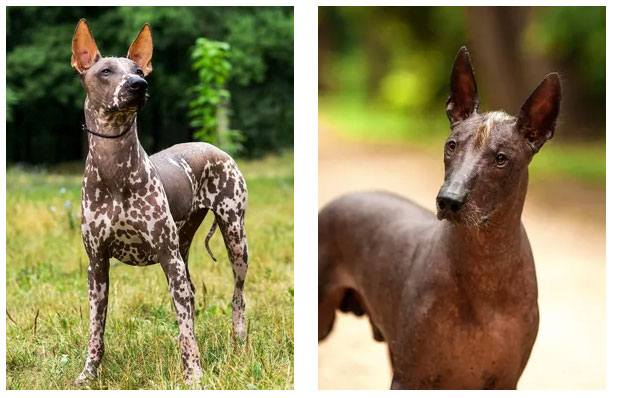
History
Xoloitzcuintli dogs have an incredible history that goes back more than 3,000 years. Xolos are one of the world's oldest breeds that evolved naturally, with archaeological evidence showing that they accompanied humans as they crossed the Bering Strait to the Americas, according to National Geographic.The Mexican hairless' name, xoloitzcuintli, comes from two words in the Aztec language: Xolotl, the god of lightning and death, and itzcuintli, which means dog. According to legend, the god Xolotl created a dog to help guard the living and guide souls through the underworld.
According to National Geographic, Xolo figurines and statues appear in ancient Mesoamerican art, often in burial sites. These hairless dogs were thought to have healing powers and ward off evil spirits for people on earth, too. Unfortunately for the xolo, that meant they were often sacrificed when their owners died so they could escort their people into the underworld.
The Aztecs also ate xoloitzcuintli meat, and when European explorers arrived they too developed a taste for the xolo, too. So much so, that they almost ate them into extinction.
In more recent centuries, xoloitzcuintlis have gone through many ebbs and flows of popularity. The American Kennel Club first recognized the breed in 1887 as the "Mexican hairless," but the breed waned in popularity and lost its AKC registration in the middle of the 20th century.
Today, the xolo is experiencing a bit of a revival: They were recognized by Mexico in 1954, and the AKC re-recognized the breed in 2011. The xoloitzcuintli is currently the official national dog of Mexico.
Fun Facts
Xolos are the mascot of Club Tijuana, the professional soccer club in Baja California.Perhaps xoloitzcuintlis' most famous owners and advocates were Mexican artists Frida Kahlo and Diego Rivera. The couple's beloved Xolos appeared with them in photographs and were featured in their artwork.
Xolos got their big break on the silver screen in Coco, the popular Pixar animated film. Mexican hairless dog Dante is protagonist Miguel's trusty companion through the underworld.